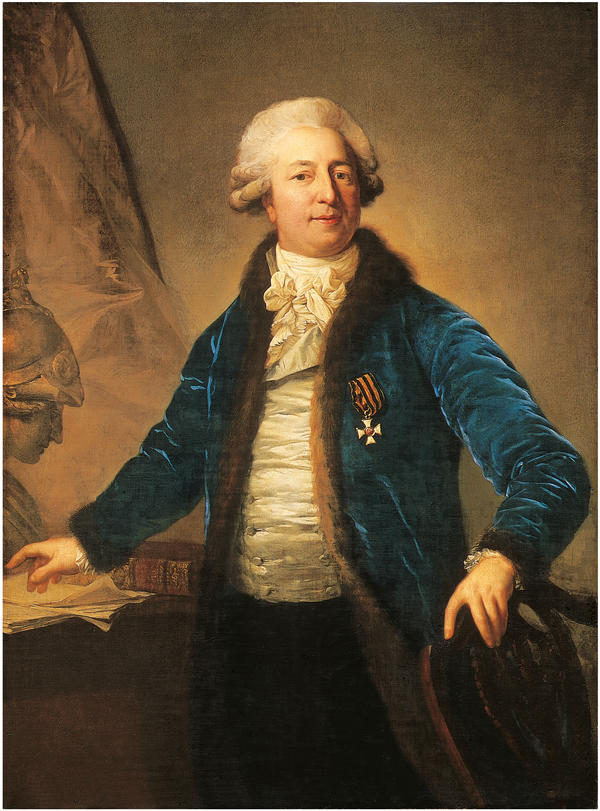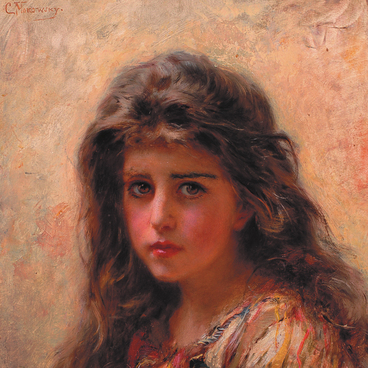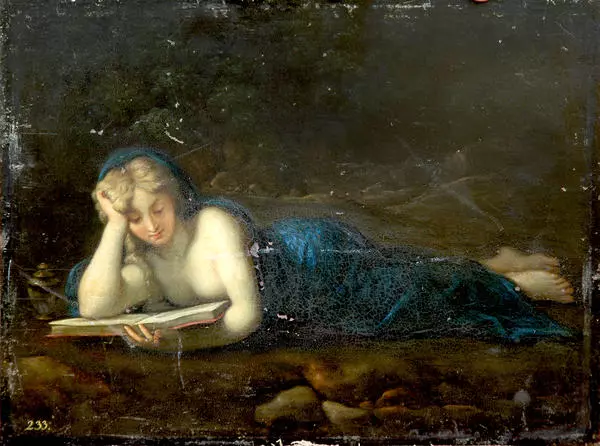Adrian Divov came from an old noble family. He served in the Navy, participated in the war with Turkey of 1768 - 1774. In 1773, he was awarded a Military order of St. George, Grade IV, for distinguished conduct in the main battle.
The following year, Divov began his career at court, starting with a position of a Chamber Junker. In 1792, he visited Stockholm in the capacity of the Special Envoy of the Russian Court at the Coronation of King Gustav IV Adolf. Six years later, he was made a Privy Councilor and a Senator.
Adrian Divov was married to Countess Elizaveta Buturlina; the couple had three sons. Probably due to the wife’s involvement in writing lampoons on Catherine II, the Divovs left St. Petersburg and went abroad. They lived in Vienna, Carlsbad and Paris; they returned to Russia prior to the war of 1812.
The set of items shown in the picture is typical for paintings of Renaissance. Documents, a folio and a bust of Goddess of Wisdom Minerva on the desk contribute to the character of the statesman. The artistic style of Anton Graff seamlessly blends credibility of characteristics with elegance of painting.
This painting was earlier attributed to Austrian artist Johann Baptist von Lampi the Elder who visited St. Petersburg in 1792 -1797. But due to paired identity of this painting to the portrait of Elizaveta Divova by Anton Graff, the experts could finally identify the actual author.
Anton Graff is a German painter born in Winterthur, a most outstanding portrait artist of his time. Since 1766 he was a resident painter at the court of the Saxon Prince in Dresden and a teacher in a local Academy of fine arts.
He painted portraits of famous personalities of that time, such as: Johann Herder, Gotthold Lessing, Friedrich von Schiller, Heinrich von Kleist, Christoph von Gluck, Moses Mendelssohn. In total, Graff painted about 1,000 portraits of his contemporaries, but his main masterpiece is believed to be the portrait of King of Prussia Frederick the Great.
Anton Graff was a favorite portrait artist of Russian, German, Polish and Baltic gentry. On commission from Empress Catherine II, in 1796, the artist copied for the Hermitage a number of paintings from the Dresden Gallery.
In the late phase of his art, Graff painted mostly landscapes; he developed a brilliant manner of painting that predated Impressionism.
Over his life, the artist created around 2,000 paintings and drawings. Many of them are kept in museums and private collections in Russia, Switzerland, Germany, Estonia and Poland.
The following year, Divov began his career at court, starting with a position of a Chamber Junker. In 1792, he visited Stockholm in the capacity of the Special Envoy of the Russian Court at the Coronation of King Gustav IV Adolf. Six years later, he was made a Privy Councilor and a Senator.
Adrian Divov was married to Countess Elizaveta Buturlina; the couple had three sons. Probably due to the wife’s involvement in writing lampoons on Catherine II, the Divovs left St. Petersburg and went abroad. They lived in Vienna, Carlsbad and Paris; they returned to Russia prior to the war of 1812.
The set of items shown in the picture is typical for paintings of Renaissance. Documents, a folio and a bust of Goddess of Wisdom Minerva on the desk contribute to the character of the statesman. The artistic style of Anton Graff seamlessly blends credibility of characteristics with elegance of painting.
This painting was earlier attributed to Austrian artist Johann Baptist von Lampi the Elder who visited St. Petersburg in 1792 -1797. But due to paired identity of this painting to the portrait of Elizaveta Divova by Anton Graff, the experts could finally identify the actual author.
Anton Graff is a German painter born in Winterthur, a most outstanding portrait artist of his time. Since 1766 he was a resident painter at the court of the Saxon Prince in Dresden and a teacher in a local Academy of fine arts.
He painted portraits of famous personalities of that time, such as: Johann Herder, Gotthold Lessing, Friedrich von Schiller, Heinrich von Kleist, Christoph von Gluck, Moses Mendelssohn. In total, Graff painted about 1,000 portraits of his contemporaries, but his main masterpiece is believed to be the portrait of King of Prussia Frederick the Great.
Anton Graff was a favorite portrait artist of Russian, German, Polish and Baltic gentry. On commission from Empress Catherine II, in 1796, the artist copied for the Hermitage a number of paintings from the Dresden Gallery.
In the late phase of his art, Graff painted mostly landscapes; he developed a brilliant manner of painting that predated Impressionism.
Over his life, the artist created around 2,000 paintings and drawings. Many of them are kept in museums and private collections in Russia, Switzerland, Germany, Estonia and Poland.




